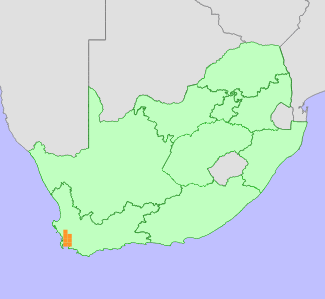|
Scientific Name | Serruria brownii Meisn. |
Higher Classification | Dicotyledons |
Family | PROTEACEAE |
Common Names | Bottlebrush Spiderhead (e) |
National Status |
Status and Criteria | Endangered A2c; B1ab(ii,iii,iv,v)+2ab(ii,iii,iv,v); C1 |
Assessment Date | 2020/08/12 |
Assessor(s) | A.G. Rebelo, H. Mtshali, R. Koopman, J. van der Merwe & D. Raimondo |
Justification | Serruria brownii is a range restricted lowland fynbos species that has an extent of occurrence (EOO) of 930-1260 km², and an area of occupancy (AOO) of 152-168 km². A population reduction of 64% is estimated to have taken place since 1995 based on field monitoring surveys (generation length 15-20 years). The total population is now estimated to consist of around 2400 mature individuals. This species has lost over 70% of its habitat to urban development and crop cultivation. The majority of remaining subpopulations are severely fragmented and continue to decline due to ongoing habitat loss and fragmentation, severe alien plant invasion, overgrazing and inappropriate fire management. It therefore qualifies for listing as Endangered under criterion A, B and C. |
Distribution |
Endemism | South African endemic |
Provincial distribution | Western Cape |
Range | This species has a limited distribution between Hopefield and Tygerberg, in the Western Cape Province, South Africa. |
Habitat and Ecology |
Major system | Terrestrial |
Major habitats | Swartland Shale Renosterveld, Swartland Granite Renosterveld, Swartland Silcrete Renosterveld, Boland Granite Fynbos, Cape Flats Sand Fynbos, Atlantis Sand Fynbos |
Description | This is a fynbos-renosterveld ecotonal species, preferring shale soils. Mature individuals are killed by fires, and only seeds survive. Seeds are released after ripening, and dispersed by ants to their underground nests, where they are protected from predation and fire. It is pollinated by insects. |
Threats |
| More than 70% of this species' habitat has been lost or degraded, predominantly due to urban expansion on the Cape Flats and around Malmesbury, including small holdings. It has also lost habitat to agriculture (cereals, vines, pasture, and chickens) between Durbanville and Malmesbury.
Remaining subpopulations are predominantly threatened by competition from alien invasive plants, veld improvement (interplanting with bigger proteas), inappropriate urban fire management, and too infrequent fire in isolated remnants. Small fragments are also often overstocked with livestock, leading to overgrazing and degradation. Additional threats include sand mining and habitat transformation from Fynbos to Thicket due to fire exclusion. |
Population |
This species is currently known from 13-20 subpopulations, there are only three viable large subpopulations remaining at Schoongezicht, Riverlands and Lemoenkloof in the Paardeberg. All other subpopulations occur in fragmented remnants on small holdings and over 50% of the population occurs in small isolated subpopulations. A total of 41% of historically recorded occurrences has been lost. Two of these are Penhill and Philadelphia-Mamre subpopulations, which were last seen in 1985 and 1940s respectively. The overall population consists of fewer than 2400 plants and ongoing decline is taking place as a result of habitat degradation from severe infestation of invasive alien plants in small fragments. From four subpopulations that have time series monitoring data, the population is suspected to have experienced a 64% decline since 1995 (2 generations).
|
Population trend | Decreasing |
Conservation |
| A reasonable subpopulation occurs in Riverlands, small subpopulations also occur at Durbanville Nature Reserve and Altydgedacht Natural Heritage Site. |
Assessment History |
Taxon assessed |
Status and Criteria |
Citation/Red List version | | Serruria brownii Meisn. | EN A2c | Raimondo et al. (2009) | | Serruria brownii Meisn. | Vulnerable | Hilton-Taylor (1996) | | Serruria brownii Meisn. | Rare | Hall et al. (1980) | |
Bibliography |
Goldblatt, P. and Manning, J.C. 2000. Cape Plants: A conspectus of the Cape Flora of South Africa. Strelitzia 9. National Botanical Institute, Cape Town.
Hall, A.V., De Winter, M., De Winter, B. and Van Oosterhout, S.A.M. 1980. Threatened plants of southern Africa. South African National Scienctific Programmes Report 45. CSIR, Pretoria.
Hilton-Taylor, C. 1996. Red data list of southern African plants. Strelitzia 4. South African National Botanical Institute, Pretoria.
Manning, J.C. and Goldblatt, P. 2012. Plants of the Greater Cape Floristic Region 1: The Core Cape Flora. Strelitzia 29. South African National Biodiversity Institute, Pretoria.
Raimondo, D., von Staden, L., Foden, W., Victor, J.E., Helme, N.A., Turner, R.C., Kamundi, D.A. and Manyama, P.A. 2009. Red List of South African Plants. Strelitzia 25. South African National Biodiversity Institute, Pretoria.
Rebelo, T. 2001. Sasol Proteas: A field guide to the proteas of southern Africa. (2nd ed.). Fernwood Press, Vlaeberg, Cape Town.
|
Citation |
| Rebelo, A.G., Mtshali, H., Koopman, R., van der Merwe, J. & Raimondo, D. 2020. Serruria brownii Meisn. National Assessment: Red List of South African Plants version . Accessed on 2025/05/31 |
 Comment on this assessment
Comment on this assessment

